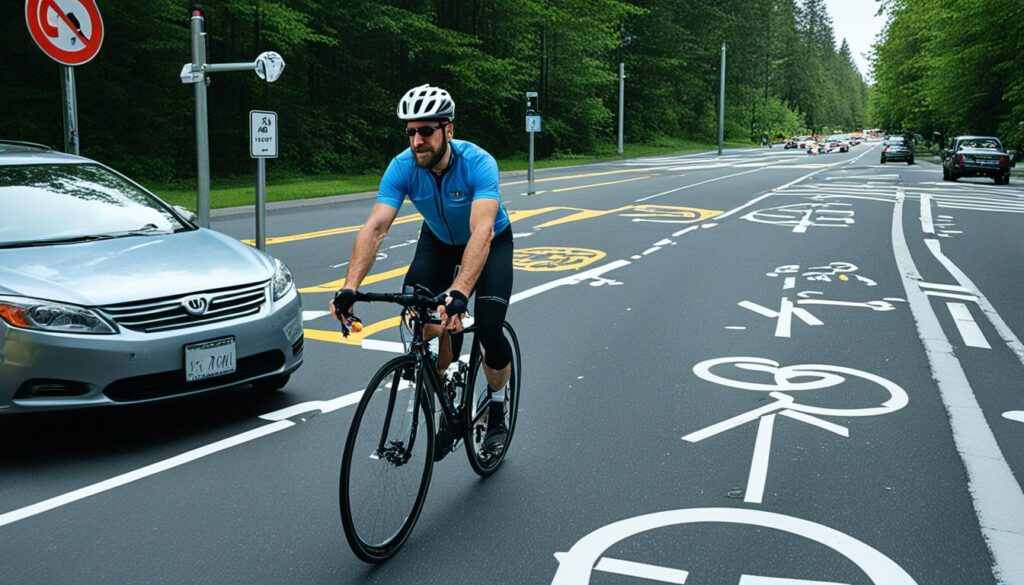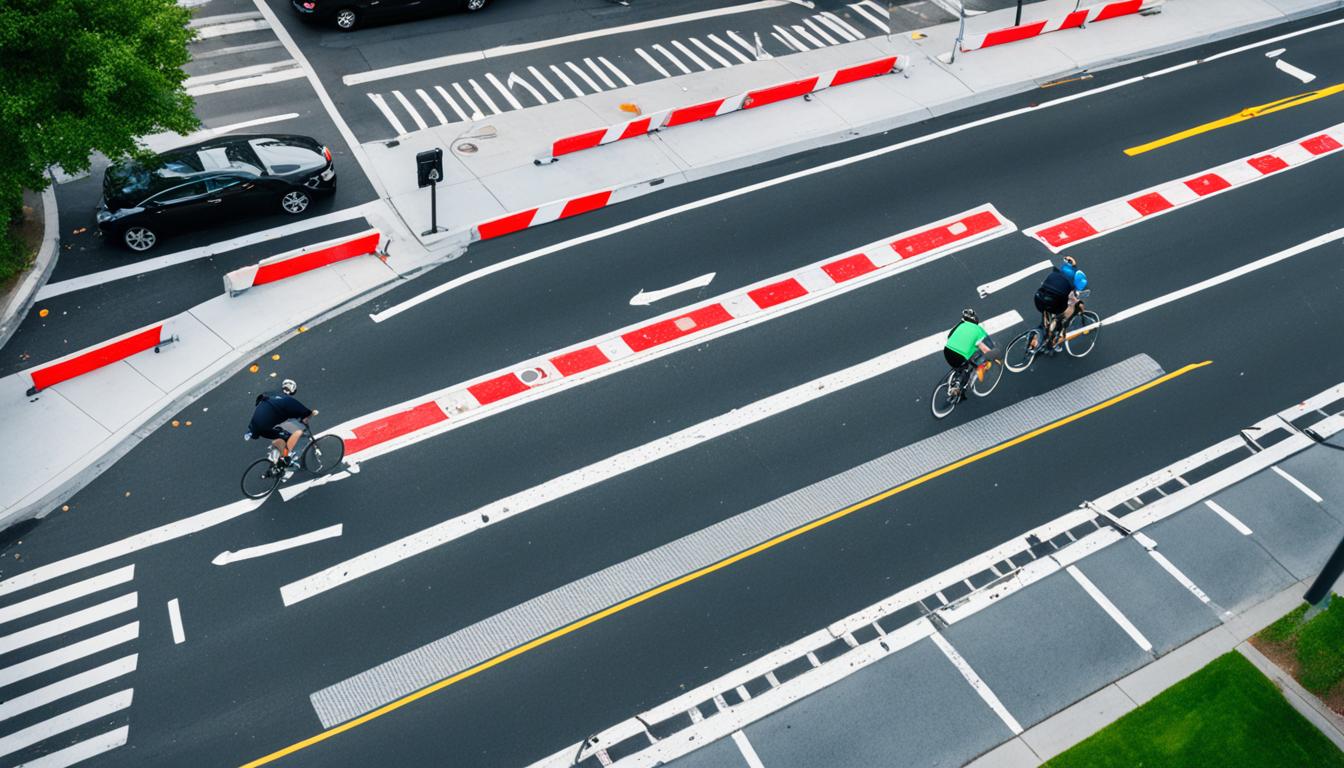When it comes to navigating bicycle lanes in Australia, it’s essential to understand the regulations and guidelines that govern their use. Bicycle lanes are special purpose lanes, dedicated to the safety and convenience of cyclists. As motorists, it’s crucial to be aware of the distance allowed in bike lanes and the exceptions that may apply.
According to the sources, in a bike lane, motorists are generally not allowed to drive, park, or stop their vehicles. The primary purpose of bike lanes is to provide an exclusive space for cyclists, ensuring their safety and encouraging sustainable modes of transport. However, there are exceptions to this rule.
According to the regulations, drivers can travel up to 50 meters in a bike lane in certain situations. These may include entering or leaving the road, avoiding an obstruction, or overtaking a right-turning vehicle. It’s important to note that the exact rules may vary slightly by state, so it’s crucial to familiarize yourself with the specific regulations in your area.
Key Takeaways:
- Motorists must not drive, park, or stop in bicycle lanes, except in specific situations.
- Drivers can travel up to 50 meters in a bike lane for certain reasons, such as entering or leaving the road, avoiding an obstruction, or overtaking a right-turning vehicle.
- Each state may have slight variations in the rules and regulations for bike lane usage, so it’s important to know the specific guidelines in your area.
- Providing sufficient space to cyclists when passing or overtaking them is crucial for road safety.
- Understanding the distinctions between bicycle lanes and bike paths is important for both drivers and cyclists to navigate the roads appropriately.
Understanding Bicycle Lanes in Australia
Bicycle lanes in Australia are marked lanes on the road that are designated for the exclusive use of cyclists. They provide a dedicated space for cyclists to ride safely and separate them from other vehicles, reducing the risk of accidents and conflicts. Cyclists can easily identify bicycle lanes through visual cues such as painted lines, bicycle symbols, and signs that indicate “bike lane” or have the word “lane” painted in white.
Some bike lanes are also colored green, further distinguishing them from regular traffic lanes. The use of colored lanes helps raise awareness among motorists and reinforces the concept of creating a safe environment for cyclists.
Both motorists and cyclists need to understand the rules and guidelines for using bike lanes to ensure safety and harmony on the roads. By adhering to these rules, motorists can contribute to the smooth flow of traffic and respect the designated space for cyclists. Likewise, cyclists should remain within bike lanes whenever possible, except when overtaking other cyclists or maneuvering around obstructions.
Exceptions for Driving in Bicycle Lanes
While motorists are generally not allowed to drive in bike lanes, there are a few exceptions. According to the sources, drivers can travel up to 50 meters in a bike lane for specific reasons. These reasons include entering or leaving the road, avoiding an obstruction, overtaking a right-turning vehicle, and setting down or picking up passengers in certain types of vehicles like taxis or buses. However, it’s important to note that these exceptions are subject to specific conditions and limitations, and the distance allowable may vary depending on the situation and state laws.
| Reason | Distance Allowed |
|---|---|
| Entering or leaving the road | Up to 50 meters |
| Avoiding an obstruction | Up to 50 meters |
| Overtaking a right-turning vehicle | Up to 50 meters |
| Setting down or picking up passengers in certain vehicles | Up to 50 meters |
Giving Space to Cyclists
When driving on a road with a bike lane, it is important for motorists to give sufficient space to cyclists while passing or overtaking them. This not only ensures the safety of cyclists but also promotes a harmonious coexistence between different road users.
Across Australia, there are specific guidelines for the minimum distance that should be maintained when overtaking a cyclist in a bike lane. These guidelines are designed to provide cyclists with enough space to safely navigate obstacles or hazards they may encounter while riding in the bike lane.
For roads with speed limits up to 60km/h, the general rule is to keep a minimum distance of one meter when passing or overtaking a cyclist in a bike lane. This allows sufficient space for both the motorist and the cyclist, reducing the risk of accidents and ensuring a safe interaction.
On the other hand, for roads with speed limits over 60km/h, the minimum distance increases to at least 1.5 meters. This additional distance is necessary due to the higher speeds involved, providing an extra buffer for both the motorist and the cyclist.
By adhering to these guidelines, motorists can contribute to the safety and well-being of cyclists while also promoting a positive and respectful atmosphere on the roads.
Stopping in Bicycle Lanes
In general, it is illegal to stop or park a vehicle in a bicycle lane. However, there may be certain situations where stopping or parking in a designated bike lane is permitted. This typically depends on the specific regulations and signage in place. If driving in a bike lane and there are no signs or road markings indicating otherwise, it may be allowed to stop or park in the bike lane. However, it’s essential to follow local laws and regulations and avoid parking in a bike lane if it is prohibited.
If you find yourself needing to make a brief stop in a bicycle lane, always prioritize the safety of cyclists. Before stopping or parking, ensure that there is no oncoming cyclist or obstruction that could potentially pose a hazard. Be vigilant and aware of your surroundings at all times to prevent any accidents or inconvenience to cyclists.
Quotes about Bike Lane Regulations:
“Bike lane regulations are put in place to ensure the safety and convenience of cyclists. It’s important for motorists to respect these regulations and refrain from stopping or parking in bike lanes.” – Catherine Thompson, Director of Road Safety Australia
Benefits of Respecting Bike Lane Guidelines:
- Enhanced safety for cyclists: By adhering to bike lane regulations, motorists contribute to creating a safe environment for cyclists to travel.
- Improved traffic flow: Keeping bike lanes clear of parked or stopped vehicles allows for smoother traffic flow, benefiting both cyclists and motorists.
- Promoting sustainable transportation: Encouraging the use of bike lanes supports cycling as a sustainable mode of transportation and reduces traffic congestion.
Remember, bicycle lanes are essential for maintaining safety and harmony on the roads for all road users. By respecting bike lane regulations and guidelines, we can create a more inclusive and efficient transportation system for everyone.

Bicycle Lanes vs. Bike Paths
When it comes to navigating the roads, it’s important to understand the difference between bicycle lanes and bike paths. While both are designed for cyclists, they have distinct characteristics that cater to different needs.
Bicycle Lanes
Bicycle lanes are designated lanes on the road that provide a dedicated space for cyclists. They are marked with painted lines, bicycle symbols, and signs indicating their presence. These lanes are integrated into the regular flow of traffic and are intended exclusively for cyclists.
Bike Paths
On the other hand, bike paths are separate trails or pathways that are primarily for cyclists (and sometimes pedestrians) and are typically located away from regular traffic. They provide a more secluded and scenic environment for cyclists to enjoy their rides, often passing through parks, nature reserves, or urban corridors.
Understanding the distinction between these two is essential for both drivers and cyclists to navigate the roads safely and responsibly. While cyclists should primarily use bicycle lanes when available, bike paths provide an alternative option for those seeking a more recreational and serene cycling experience.
Benefits of Bicycle Lanes:
Incorporating dedicated bicycle lanes into road infrastructure offers a range of benefits for both cyclists and motorists. Some of these benefits include:
- Enhanced Safety: Bicycle lanes provide a designated space for cyclists, separating them from motor vehicle lanes and reducing the likelihood of accidents or conflicts.
- Promotion of Active Transport: By making cycling safer and more accessible, bicycle lanes encourage more people to choose sustainable modes of transportation, resulting in a more active and healthier population.
Benefits of Bike Paths:
While bicycle lanes are designed for commuting and transportation purposes, bike paths offer additional advantages, including:
- Scenic Riding Opportunities: Bike paths are often set in picturesque environments, allowing cyclists to enjoy their rides in a more serene and nature-filled atmosphere.
- Escape from Traffic: With bike paths located away from regular roads, cyclists can avoid the noise, congestion, and potential dangers associated with motor vehicle traffic.
Both bicycle lanes and bike paths contribute to creating a more cyclist-friendly infrastructure that promotes sustainable transportation and a healthier lifestyle. By understanding their differences, drivers and cyclists can coexist harmoniously, ensuring the safety and enjoyment of everyone on the road.
Enforcement and Penalties
Violating bike lane regulations and rules can result in penalties and fines. It is essential for drivers to be aware of and adhere to the rules surrounding bicycle lanes to contribute to a safer road environment for all users.
“Respecting bike lane regulations is not only a legal requirement but also a matter of safety for cyclists.”
When drivers are found driving, parking, or stopping in a bike lane illegally, they may face consequences. The specific fines and penalties vary across Australian states and depend on the severity of the violation. It is important for drivers to understand these regulations to avoid potential fines.
Penalties for Violating Bike Lane Rules
The penalties for violating bike lane rules can vary depending on the state and the specific offense. Some common penalties include:
| Violation | Penalty |
|---|---|
| Driving in a bike lane | Fine of up to $500* |
| Parking or stopping in a bike lane | Fine of up to $200* |
| Blocking a bike lane | Fine of up to $300* |
*Penalties may vary. Please refer to the specific regulations in your state for accurate information.
These penalties are in place to encourage compliance with bike lane regulations and ensure the safety of cyclists. By respecting bike lane rules, drivers can contribute to a harmonious and inclusive road environment, promoting the well-being of all road users.
Importance of Bicycle Lanes
Bicycle lanes play a crucial role in promoting safety and harmony on the roads for both cyclists and motorists. By providing a designated space for cyclists, bicycle lanes help to reduce the risk of accidents and conflicts with motor vehicles, creating a safer environment for all road users.
One of the key benefits of bicycle lanes is that they help make road travel more predictable. By clearly separating cyclists from other traffic, bike lanes enhance visibility and allow both cyclists and motorists to anticipate each other’s movements. This reduces the likelihood of abrupt maneuvers or unexpected interactions, leading to a smoother flow of traffic.
Investing in bicycle lane infrastructure is not just about creating dedicated spaces for cyclists. It is also a way for government authorities to support and encourage cycling as a mode of transport. By prioritizing the development and maintenance of bicycle lanes, authorities demonstrate their commitment to promoting sustainable transportation options and reducing congestion on the roads.
Beyond the immediate benefits of safety and reduced traffic, bicycle lanes also have a positive impact on the community as a whole. Encouraging cycling as a means of transportation contributes to improved health outcomes by promoting physical activity and reducing sedentary behavior. Additionally, choosing to ride a bicycle instead of driving a car helps reduce carbon emissions and supports efforts to combat climate change.
As the importance of sustainable transport and active lifestyles continues to gain recognition, the role of bicycle lanes in creating a cycling-friendly infrastructure becomes increasingly significant. By prioritizing the development and expansion of bicycle lanes, authorities can effectively cater to the needs of cyclists, create safer roads, and contribute to the overall well-being of the community.
Government Initiatives for Cycling Safety
The Australian government is committed to enhancing cycling safety through various infrastructure and initiatives. One crucial aspect of this commitment is the development and maintenance of bicycle lanes across the country. These dedicated lanes provide a safe and designated space for cyclists to ride, separate from motor vehicle traffic.

Over the years, the length of bike lanes in many areas, including the greater Adelaide region, has doubled to accommodate the growing number of cyclists. The government recognizes the importance of promoting cycling as a safe and sustainable mode of transport, and initiatives have been introduced to encourage more people to cycle in Australia.
“The development of bicycle lanes is an integral part of our commitment to creating a safer environment for cyclists and motorists alike. We believe that by investing in infrastructure and promoting cycling, we can enhance road safety and encourage a healthier and more environmentally friendly means of transportation.”
Government Programs and Partnerships
The Australian government has implemented various programs and partnerships with local councils to promote cycling safety and increase the number of people cycling in the country. These initiatives include:
- Education campaigns to raise awareness about bike lane regulations and safe cycling practices
- Infrastructure improvements to create safer and more accessible bike lanes
- Cycling events and community outreach programs to encourage participation and engagement
- Collaboration with law enforcement agencies to enforce bike lane regulations and ensure compliance
The Benefits of Cycling
Promoting cycling as a safe and viable mode of transport offers numerous benefits to individuals and communities. Cycling helps reduce traffic congestion, lowers carbon emissions, and improves overall air quality. Furthermore, it promotes physical activity and leads to better health outcomes for individuals.
| Benefits of Cycling | Individuals | Communities |
|---|---|---|
| Improved fitness and cardiovascular health | Reduced healthcare costs | Healthier and more active communities |
| Economical mode of transportation | Savings on fuel and parking expenses | Reduction in traffic congestion |
| Reduced carbon footprint | Environmental sustainability | Improved air quality |
By investing in bicycle lanes and promoting cycling safety, the government aims to create a positive cycling culture and encourage more people to choose bicycles as a means of transportation, leading to a healthier, greener, and more vibrant Australia.
Sharing the Road Responsibly
When it comes to using bicycle lanes, both drivers and cyclists have a shared responsibility to ensure safety and harmony on the roads. By following the rules and guidelines, we can create an environment where everyone can coexist peacefully.
First and foremost, it’s crucial for motorists to be aware of the presence of cyclists in bike lanes. This means giving them enough space when overtaking or passing. By doing so, we can avoid potential accidents and ensure the safety of all road users.
Motorists should also refrain from driving, parking, or stopping in a bike lane unless it is explicitly permitted in specific situations. This allows cyclists to have uninterrupted access to the designated space meant for them. By respecting the boundaries of bike lanes, we can avoid unnecessary conflicts and congestion on the roads.
On the other hand, cyclists should make an effort to ride within the bike lane whenever possible. This helps maintain a smooth flow of traffic and reduces the risk of accidents. However, it’s important to note that cyclists may need to deviate from the bike lane temporarily to avoid obstructions or overtake other cyclists. In such cases, they should always exercise caution and ensure the safety of themselves and others.
“By sharing the road responsibly, we can create a safer and more harmonious environment for all road users.”
Shared responsibility and mutual respect are essential in fostering a positive and cooperative road culture. By adhering to bike lane guidelines and rules, we can contribute to the overall safety and well-being of everyone on the road.
Road-sharing Tips:
- Always check for cyclists before entering or exiting a road.
- Give cyclists enough space when overtaking or passing.
- Avoid driving, parking, or stopping in a bike lane unless permitted.
- Cyclists should ride within the bike lane whenever possible.
- Communicate with hand signals and follow traffic signals.
- Be patient and understanding of all road users.
Conclusion
Understanding bike lane regulations and guidelines is crucial for both drivers and cyclists in Australia. While motorists are generally prohibited from driving in bike lanes, there are exceptions for specific situations such as entering or leaving the road, avoiding obstructions, or overtaking right-turning vehicles. These rules exist to ensure the safety and harmony of all road users.
When sharing the road with cyclists on roads with bike lanes, drivers must give sufficient space when passing or overtaking them. By following the recommended minimum distance and respecting the designated bike lanes, we can create a safer environment for everyone.
It is essential for both drivers and cyclists to know the specific regulations in their area and adhere to them. By staying informed and sharing the road responsibly, we can ensure the smooth and efficient operation of bike lanes and contribute to the overall safety of our roads.
